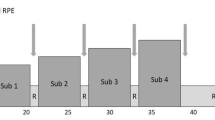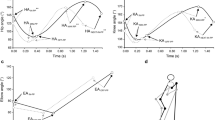Abstract
During competitions, elite cross-country skiers produce higher external work rates on uphill than on flat terrain. However, it is not presently known whether this reflects solely higher energy expenditure. Furthermore, the kinematic factors associated with these higher rates of uphill work have not yet been examined. Therefore, in the present investigation the work rate and associated kinematic parameters at similar metabolic rates during roller ski skating on flat and uphill terrains have been compared. Seven elite male skiers performed six 5-min sub-maximal exercise bouts at the same low, moderate and high metabolic rates on 2 and 8% inclines, while roller skiing on a treadmill employing the G3 skating technique. The work rate was calculated as work against gravity and friction, whereas the energetic equivalent of VO2 was taken as the metabolic rate. Gross efficiency was defined as work rate divided by metabolic rate. Kinematic parameters were analyzed in three dimensions. At the same metabolic rate, the work rate, cycle rate, work per cycle and relative duration of propulsive phases during a cycle of movement were all higher on the 8% than on the 2% incline at all speeds (all P < 0.05). At similar work rates, gross efficiency was greater on the 8% incline (P < 0.05). In conclusion, these elite skiers consistently demonstrated higher work rates on the 8% incline. To achieve the higher work rates on the steeper incline, these elite skiers employed higher cycle rates and performed more work per cycle, in association with a longer relative propulsive phase.




Similar content being viewed by others
References
Andersson E, Supej M, Sandbakk Ø, Sperlich B, Stöggl T, Holmberg H-C (2010) Analysis of sprint cross-country skiing using a differential global navigation satellite system. Eur J Appl Physiol 110:585–595
Bergh U, Forsberg A (2000) Cross-country ski racing. In: Shephard RJ, Åstrand PO (eds) Endurance in sport, 2nd edn. Blackwell, Oxford, pp 844–856
Bilodeau B, Boulay MR, Roy B (1992) Propulsive and gliding phases in four cross-country skiing techniques. Med Sci Sports Exerc 24:917–925
Boulay MR, Serresse O, Almeras N, Tremblay A (1994) Energy expenditure measurement in male cross-country skiers: comparison of two field methods. Med Sci Sports Exerc 26:248–253
Crowder M, Hand D (1990) Analysis of repeated measures. Chapman & Hall, London
di Prampero PE, Ferretti G (1999) The energetics of anaerobic muscle metabolism: a reappraisal of older and recent concepts. Respir Physiol 118:103–115
Durnin JV, Womersley J (1973) Total body fat, calculated from body density, and its relationship to skinfold thickness in 571 people aged 12–72 years. Proc Nutr Soc 32:45
Ettema G, Loras HW (2009) Efficiency in cycling: a review. Eur J Appl Physiol 106:1–14
FIS (2009) International ski federation world cup results. Available at http://www.fis-ski.com
Holmberg H-C, Lindinger S, Stöggl T, Eitzlmair E, Muller E (2005) Biomechanical analysis of double poling in elite cross-country skiers. Med Sci Sports Exerc 37:807–818
Holmberg HC, Rosdahl H, Svedenhag J (2007) Lung function, arterial saturation and oxygen uptake in elite cross country skiers: influence of exercise mode. Scand J Med Sci Sports 17:437–444
Ingjer F (1991) Maximal oxygen uptake as a predictor of performance ability in woman and man elite cross-country skiers. Scand Med Sport Exerc 1:25–30
Kvamme B, Jakobsen B, Hetland S, Smith G (2005) Ski skating technique and physiological responses across slopes and speeds. Eur J Appl Physiol 95:205–212
Lindinger SJ, Stöggl T, Muller E, Holmberg H-C (2009) Control of speed during the double poling technique performed by elite cross-country skiers. Med Sci Sports Exerc 41:210–220
Medbo JI, Mamen A, Holt Olsen O, Evertsen F (2000) Examination of four different instruments for measuring blood lactate concentration. Scand J Clin Lab Invest 60:367–380
Millet GY, Hoffman MD, Candau RB, Buckwalter JB, Clifford PS (1998a) Effect of rolling resistance on poling forces and metabolic demands of roller skiing. Med Sci Sports Exerc 30:755–762
Millet GY, Hoffman MD, Candau RB, Clifford PS (1998b) Poling forces during roller skiing: effects of grade. Med Sci Sports Exerc 30:1637–1644
Millet GY, Hoffman MD, Candau RB, Clifford PS (1998c) Poling forces during roller skiing: effects of technique and speed. Med Sci Sports Exerc 30:1645–1653
Millet GP, Tronche C, Fuster N, Candau R (2002) Level ground and uphill cycling efficiency in seated and standing positions. Med Sci Sports Exerc 34:1645–1652
Minetti AE (2011) Bioenergetics and biomechanics of cycling: the role of ‘internal work’. Eur J Appl Physiol 111:323–329
Minetti AE, Moia C, Roi GS, Susta D, Ferretti G (2002) Energy cost of walking and running at extreme uphill and downhill slopes. J Appl Physiol 93:1039–1046
Mognoni P, Rossi G, Gastaldelli F, Canclini A, Cotelli F (2001) Heart rate profiles and energy cost of locomotion during cross-country skiing races. Eur J Appl Physiol 85:62–67
Nilsson J, Tveit P, Eikrehagen O (2004) Effects of speed on temporal patterns in classical style and freestyle cross-country skiing. Sports Biomech 3:85–107
Norman RW, Komi PV (1987) Mechanical energetics of world-class cross-country skiing. Int J Sport Biomech 3:353–369
Norman RW, Ounpuu S, Fraser M, Mitchell R (1989) Mechanical power output and estimated metabolic rates of Nordic skiers during Olympic competition. Int J Sports Biomech 5:169–184
Peronnet F, Massicotte D (1991) Table of nonprotein respiratory quotient: an update. Can J Sport Sci 16:23–29
Sandbakk Ø, Holmberg H-C, Leirdal S, Ettema G (2010) Metabolic rate and gross efficiency at high work rates in world class and national level sprint skiers. Eur J Appl Physiol 109:473–481
Sandbakk Ø, Ettema G, Leirdal S, Jakobsen V, Holmberg H-C (2011) Analysis of a sprint ski race and associated laboratory determinants of world-class performance. Eur J Appl Physiol 111:947–957
Smith GA (1992) Biomechanical analysis of cross-country skiing techniques. Med Sci Sports Exerc 24:1015–1022
Stöggl TL, Müller E (2009) Kinematic determinants and physiological response of cross-country skiing at maximal speed. Med Sci Sports Exerc 41:1476–1487
van Ingen Schenau GJ, Cavanagh PR (1990) Power equations in endurance sports. J Biomech 23:865–881
Acknowledgments
This study was supported financially by the Mid-Norway Division of the Norwegian Olympic Committee. The authors would like to thank the participants and their coaches for their enthusiastic cooperation.
Author information
Authors and Affiliations
Corresponding author
Additional information
Communicated by Jean-René Lacour.
Rights and permissions
About this article
Cite this article
Sandbakk, Ø., Ettema, G. & Holmberg, HC. The influence of incline and speed on work rate, gross efficiency and kinematics of roller ski skating. Eur J Appl Physiol 112, 2829–2838 (2012). https://doi.org/10.1007/s00421-011-2261-0
Received:
Accepted:
Published:
Issue Date:
DOI: https://doi.org/10.1007/s00421-011-2261-0




